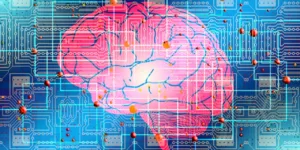Artificial Intelligence has been trending in the IT industry for quite a long time now. There are mixed emotions regarding how AI is influencing, if not controlling, the way we live, work and entertain ourselves. Virtual personal assistants, movies recommendations, avoiding traffic, instant machine translation, self-driving vehicles, are some applications of AI that show how it is seeping into our lives today.
Here are a few examples of how far AI is becoming a part of our daily lives.
Natural Language Generation
Choosing the right words in the right sequence to convey a message that can be easily understood by the listener is not always easy. And it is even trickier for a machine, which processes information entirely different than a human brain. That’s where Natural Language Processing comes in. NLP helps a computer understand, interpret and manipulate human language. It makes it possible for computers to read the text or hear speech, interpret it, measure sentiment and determine which parts are important.
The evolution of NLP has a lot of applications for businesses. Just imagine the power of an algorithm that can understand the meaning and nuance of human language in many contexts. As the volume of unstructured information continues to grow, we will benefit from computers’ ability to help us make sense of all of it.
Image Recognition
It is a process of identifying and detecting an object in a digital image, and AI is increasingly being stacked on top of this technology to great effect. Artificial Intelligence can search around the social media platforms for pictures and compare them to a wide range of data sets in order to decide which ones are most relevant.
From a business perspective, major applications of image recognition technology include security features, face recognition, object recognition, code recognition, etc.
Speech Recognition
Speech recognition is the technology that can recognize spoken words, which can then be converted to text. Think about how a child learns a language. They absorb all the cues and pronunciations from the sounds they hear around them, and their brains form patterns and connections based on it. Speech recognition works in the same way:
The user speaks some words by invoking the voice recognition application. These words are processed by the software and converted to text. And the text is then provided as input to the search mechanism.
Google’s machine learning algorithms have almost 95% word accuracy rate for the English language.
Machine Learning Platforms
Machine learning is an application of AI that provides systems the ability to automatically learn from experience without being explicitly programmed. This technology focuses on the development of computer programs that can access data and use it to learn for themselves.
By providing algorithms, APIs development and training tools and, big data, ML platforms are gaining more traction every day.
Most industries working with heaps of data have recognized the value of machine learning technology. By gleaning insights from this data, often in real time, organizations are working more efficiently and gaining an advantage over their competitors.
Virtual Agents
A Virtual Assistant is a computer-generated virtual character that serves as an online customer service representative. It leads an intelligent conversation with users, respond to their queries and performs accordingly. There is no denying the fact that virtual agents or “chatbots” are a rapid advance in innovation and technology.
They are currently being used in customer service and as a smart home manager.
Robotic Processes Automation
Robotics Process Automation automates the daily manual tasks to increase productivity and save time. It uses scripts and methods that mimic and automate these tasks. It is particularly useful for situations where hiring humans for a specific job is too expensive or inefficient.
A good example of RPA is Adext AI, a platform that automates digital advertising processes, saving businesses from devoting huge working hours to mechanical and repetitive tasks.
Decision Management
AI and decision management together can help companies make valid decisions by performing analytic functions and providing relevant information. Combining AI and decision management systems can take decision-making to the next level. The power of AI helps the decision management systems to translate customer data into predictive models of key trends. This helps marketing and consumer departments customize their efforts according to key demographics.
Deep Learning Platforms
Deep learning is the fastest growing field and the new big trend in AI. It is a set of algorithms that use artificial neural networks in order to learn in multi-levels, corresponding to different levels of abstraction.
In short, deep learning and all facets of AI use data to make human-like “intelligent” decisions. Deep learning teaches computers to learn by data. For instance, deep learning is used for driverless cars, enabling vehicles to recognize other vehicles, stop signs, and even pedestrians. Deep learning also lays at the center of consumer products like voice assistant drove smart speakers, facial recognition technology, and even on some popular web pages.
Content Creation
AI plays a significant role in content marketing, helping to streamline processes at a time of immense content overload. The rules of content marketing keep changing every year and AI is helping marketers decipher the ever-changing world of content marketing by analyzing data and helping make sense of user intent.
A SaaS tool called Wibbitz helps publishers to create videos from written content in minutes with AI video production technology. Wordsmith is another tool that applies Natural Language Processing to generate news stories based on earnings data.
Biometrics
Biometrics deals with the identification, measurement, and analysis of physical aspects of a body structure and human behavior. It allows natural interactions between humans and machines, including touch, image, speech, and body language recognition.
Biometrics are used in different fields like,
Law enforcement- Fingerprint authentication systems.
Border control- Electronic passports which store fingerprint data.
Healthcare- ID and health insurance programs which may use fingerprints for identification.
Although we don’t know what the future holds for AI, it is quite evident that interacting with it is soon going to become an everyday activity. Hence, it would be a good idea for business leaders to embrace AI’s transformative potential and, in doing so, take a responsible approach to it. Because being at the forefront doesn’t only mean making clever decisions, it means adapting to the latest technologies.








